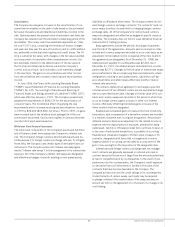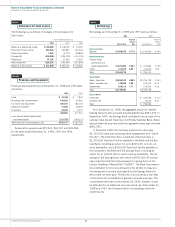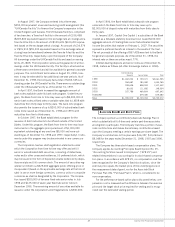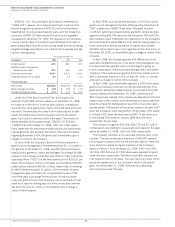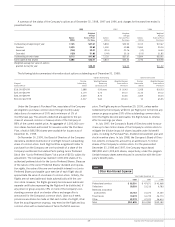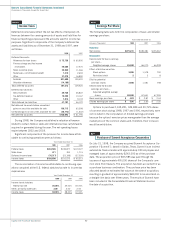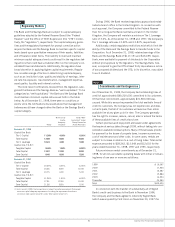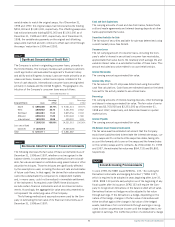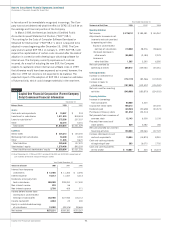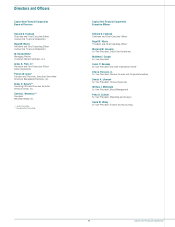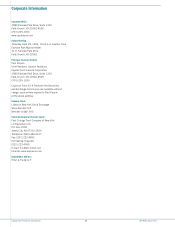Capital One 1998 Annual Report Download - page 55
Download and view the complete annual report
Please find page 55 of the 1998 Capital One annual report below. You can navigate through the pages in the report by either clicking on the pages listed below, or by using the keyword search tool below to find specific information within the annual report.
53 Capital One Financial Corporation
Cash and Cash Equivalents
The carrying amounts of cash and due from banks, federal funds
sold and resale agreements and interest-bearing deposits at other
banks approximated fair value.
Securities Available for Sale
The fair value of securities available for sale was determined using
current market prices. See Note B.
Consumer Loans
The net carrying amount of consumer loans, including the Com-
pany’s seller’s interest in securitized consumer loan receivables,
approximated fair value due to the relatively short average life and
variable interest rates on a substantial number of these loans. This
amount excluded any value related to account relationships.
Interest Receivable
The carrying amount approximated fair value.
Interest Only Strips
The fair value of the I/O strips was determined using discounted
cash flow calculations. Cash flows are estimated based on the latest
forecast for the activity related to securitized loans.
Borrowings
The carrying amounts of interest-bearing deposits, other borrowings
and deposit notes approximated fair value. The fair value of senior
notes was $3,769,000 and $3,351,000 as of December 31,
1998 and 1997, respectively, and determined based on quoted
market prices.
Interest Payable
The carrying amount approximated fair value.
Off-Balance Sheet Financial Instruments
The fair value was the estimated net amount that the Company
would have (paid)/received to terminate the interest rate swaps, cur-
rency swaps and f/x contracts at the respective dates, taking into
account the forward yield curve on the swaps and the forward rates
on the currency swaps and f/x contracts. As of December 31, 1998
and 1997, the estimated fair value was $(64,713) and $5,800,
respectively.
Note R
Recent Accounting Pronouncements
In June 1998, the FASB issued SFAS No. 133, “Accounting for
Derivative Instruments and Hedging Activities” (“SFAS 133”),
which is required to be adopted in years beginning after June 15,
1999. SFAS 133 permits early adoption as of the beginning of any
fiscal quarter after its issuance. SFAS 133 will require the Com-
pany to recognize all derivatives on the balance sheet at fair value.
Derivatives that are not hedges must be adjusted to fair value
through earnings. If the derivative is a hedge, depending on the
nature of the hedge, changes in the fair value of derivatives will
either be offset against the change in fair value of the hedged
assets, liabilities or firm commitments through earnings or recog-
nized in other comprehensive income until the hedged item is rec-
ognized in earnings. The ineffective portion of a derivative’s change
variable rates to match the original swaps. As of December 31,
1998 and 1997, the original swaps had notional amounts totaling
$291,000 and $1,041,000, respectively. The offsetting swaps also
had notional amounts totaling $291,000 and $1,041,000 as of
December 31, 1998 and 1997, respectively. As of December 31,
1998, the variable rate payments on the original and offsetting
swaps were matched and will continue to offset each other through
the swaps’ maturities in 1999 and 2000.
Note P
Significant Concentration of Credit Risk
The Company is active in originating consumer loans, primarily in
the United States. The Company reviews each potential customer’s
credit application and evaluates the applicant’s financial history
and ability and willingness to repay. Loans are made primarily on an
unsecured basis; however, certain loans require collateral in the
form of cash deposits. International consumer loans are originated
primarily in Canada and the United Kingdom. The geographic dis-
tribution of the Company’s consumer loans was as follows:
Year Ended December 31
1998 1997
Percentage Percentage
Geographic Region Loans of Total Loans of Total
South $ 5,868,386 33.74% $ 5,061,414 35.57%
West 3,609,952 20.75 3,361,556 23.62
Northeast 3,032,061 17.43 2,835,256 19.92
Midwest 2,992,334 17.20 2,533,469 17.80
International 1,892,393 10.88 439,320 3.09
17,395,126 100.00% 14,231,015 100.00%
Less securitized
balances (11,238,015) (9,369,328)
Total $ 6,157,111 $ 4,861,687
Note Q
Disclosures About Fair Value of Financial Instruments
The following discloses the fair value of financial instruments as of
December 31, 1998 and 1997, whether or not recognized in the
balance sheets. In cases where quoted market prices are not avail-
able, fair values are based on estimates using present value or other
valuation techniques. Those techniques are significantly affected
by the assumptions used, including the discount rate and estimates
of future cash flows. In that regard, the derived fair value estimates
cannot be substantiated by comparison to independent markets
and, in many cases, could not be realized in immediate settlement
of the instrument. As required under GAAP, these disclosures
exclude certain financial instruments and all non-financial instru-
ments. Accordingly, the aggregate fair value amounts presented do
not represent the underlying value of the Company.
The following methods and assumptions were used by the Com-
pany in estimating the fair value of its financial instruments as of
December 31, 1998 and 1997:


